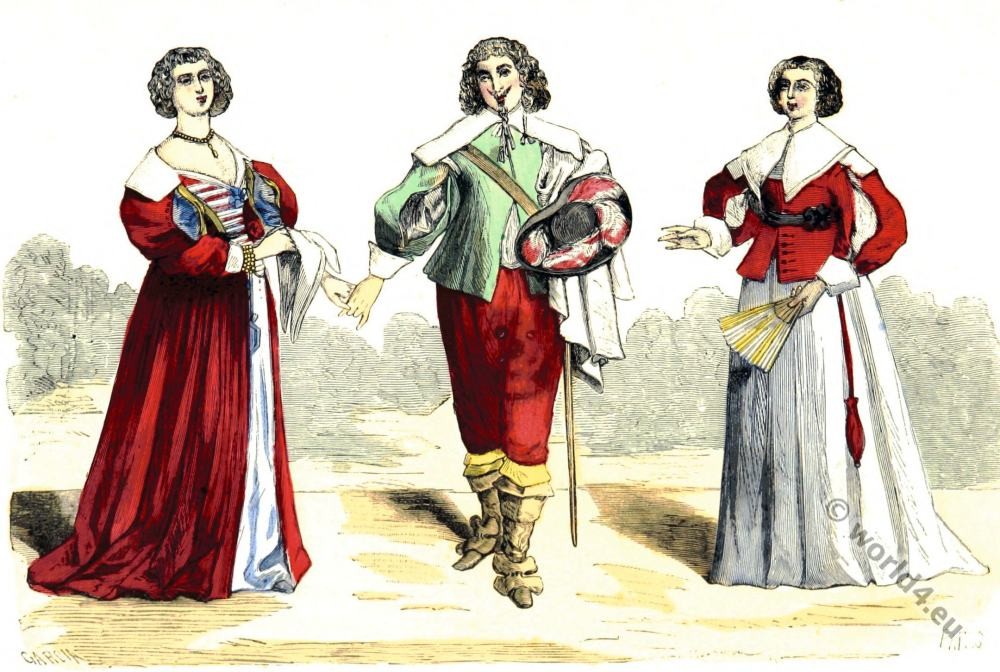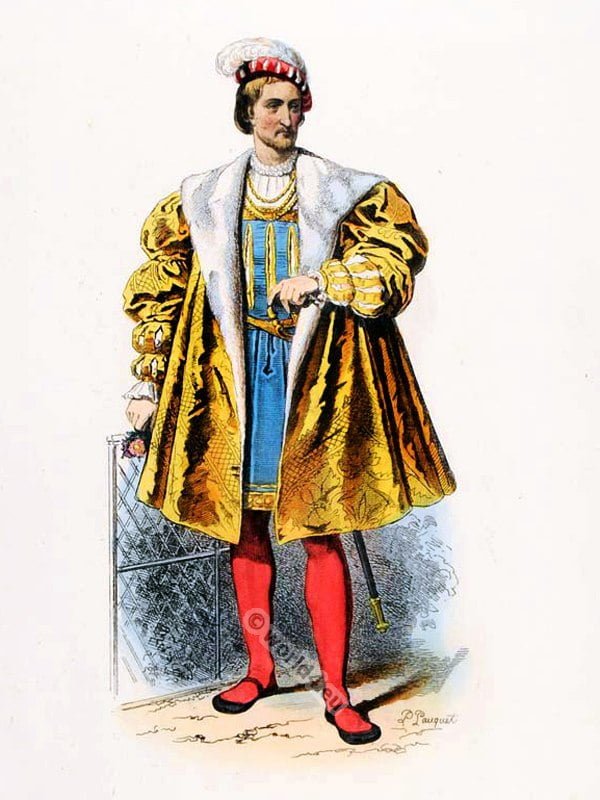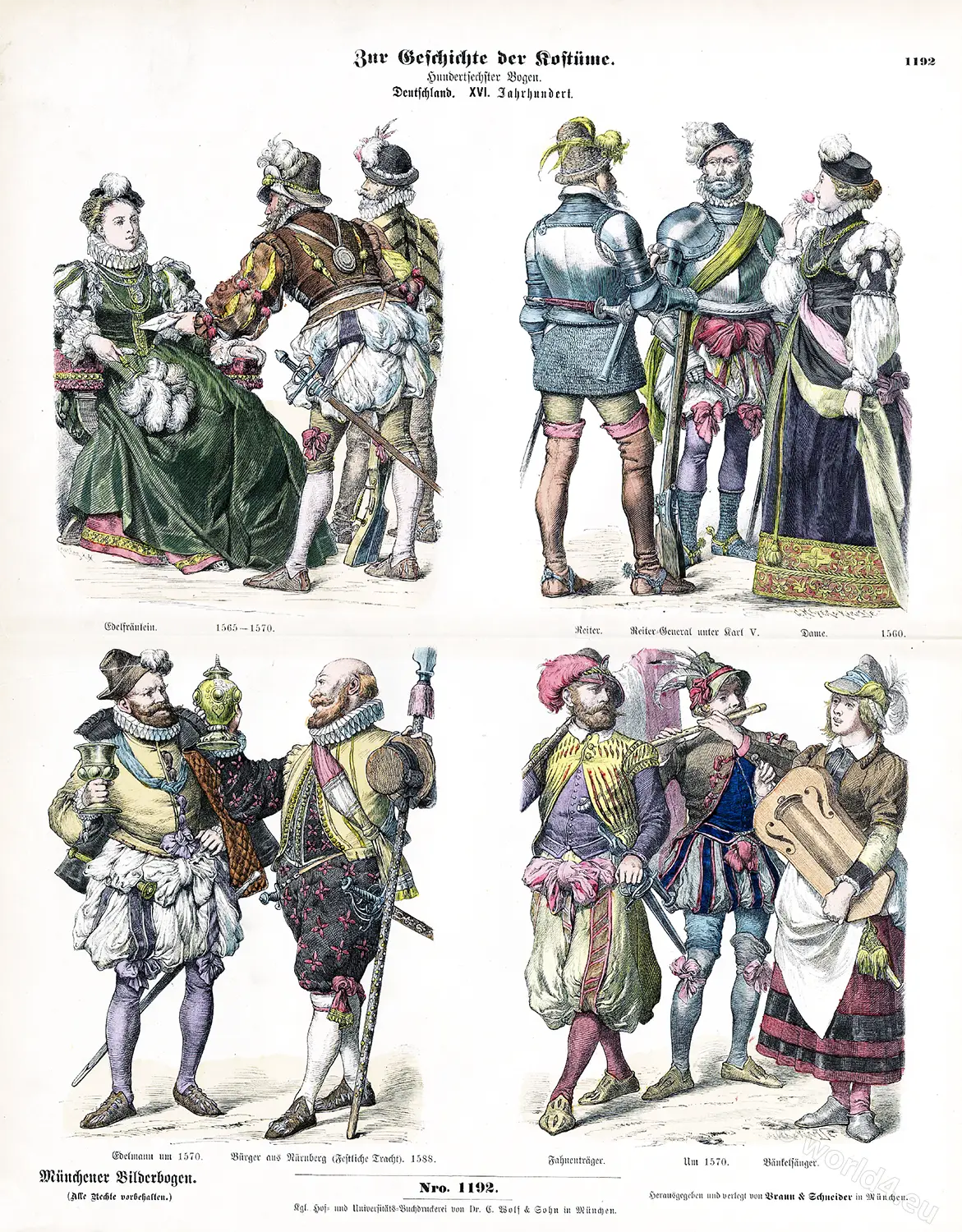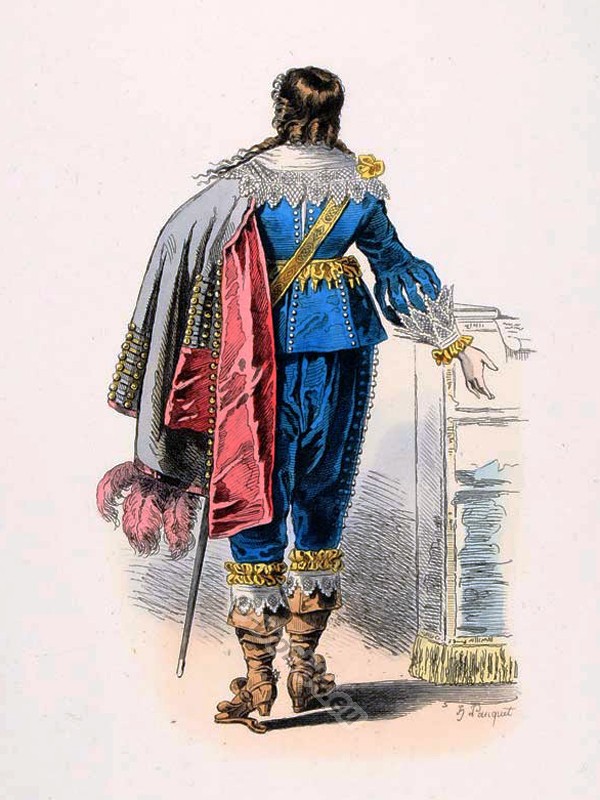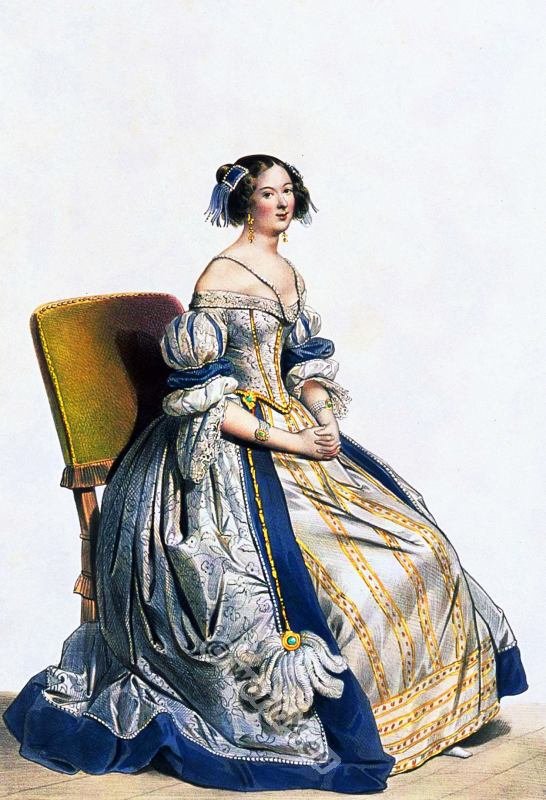
Fashion in the Reigns of Henri IV. and Louis XIII. 1590 to 1614.
Table of Content
Universal mourning on the death of the Guises; intolerance of showy dress — Vertugadins, “espoitrement,” “corps espagnole” — Diversity of colours — The pearls, jewels, and diamonds belonging to Gabrielle d’Estrees and to the queen — Dress of Marguerite de France — Low-cut bodices — Head-dresses of hair — Various styles — Venetian slippers — Edicts of Louis XII. — Caricatures: “Pompe funèbre de la Mode” — Words and fashions — Ribbons or “galants” — Dress of widows — “Demi-ceint” girdles — Gloves of all sorts – Patches — Masks; their use — “Cache-laid” — The Frondeuses — Mme. de Longueville.
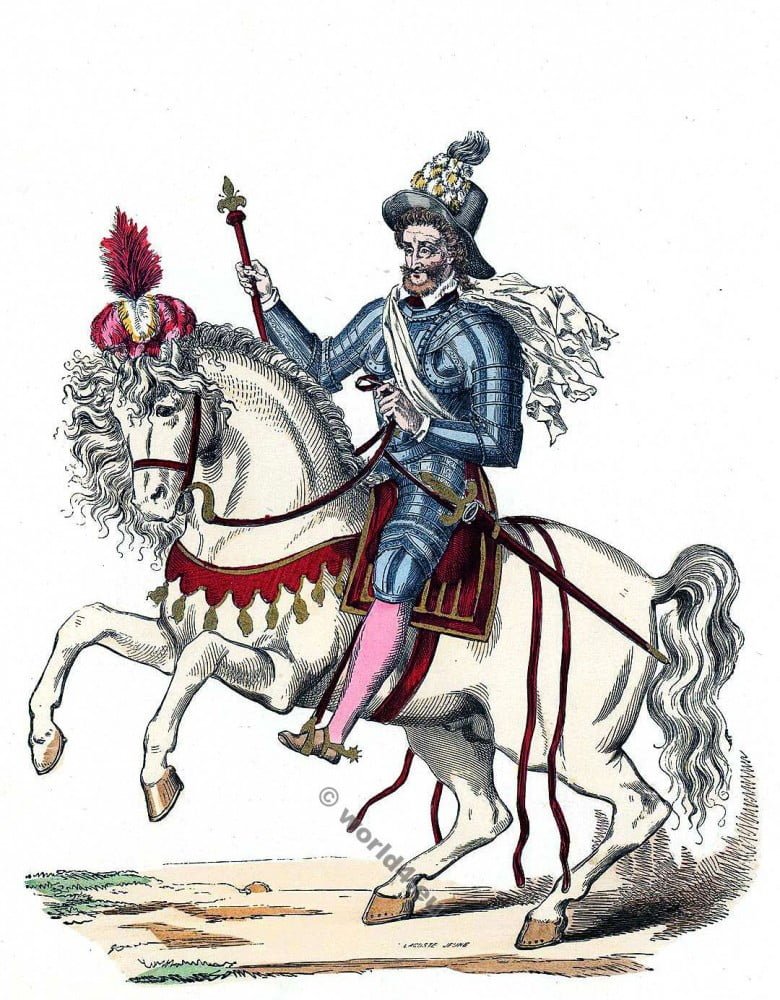
Equestrian portrait of Henri IV in 1596 on horseback, aged 45. King of France.
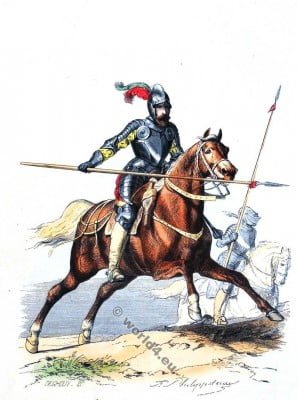


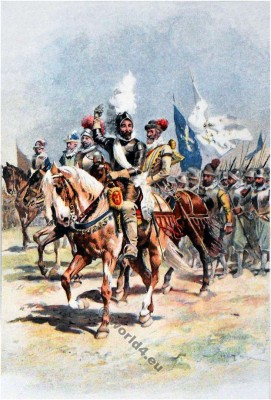
Henri IV, of Navarre (French Henri IV, Henri Quatre, Henri le Grand, Occitan Enric Quate Lo Gran; * December 13, 1553 in Pau, Navarre; – May 14, 1610 in Paris) was King of Navarre from June 9, 1572 as Henri III and King of France from August 2, 1589 until his assassination on May 14, 1610 as Henri IV. In his Gascon homeland, he was called lo nòstre bon rei Enric (for “our good King Henri”) in the local language.
Henri played a central role in the Huguenot Wars as the first prince of high nobility and leader of the Huguenot party. After the House of Valois died out, he inherited the French crown and became the first king from the House of Bourbon.
For four years, however, which were strongly marked by internal French disputes, Henri IV (as a Calvinist) remained the only Protestant king in the history of France. However, he was only able to finally assert himself on the throne of France after his conversion to Catholicism in 1593.
As king, Henri IV rebuilt the country shattered by the civil wars and formed the foundations of the French unitary state. The Edict of Nantes, which assured French Protestants freedom of worship, was one of the most authoritative decrees of his reign.
In terms of foreign policy, he repositioned the country as a major power to be taken seriously and resumed France’s struggle against the House of Habsburg in order to regain dominance in Europe.
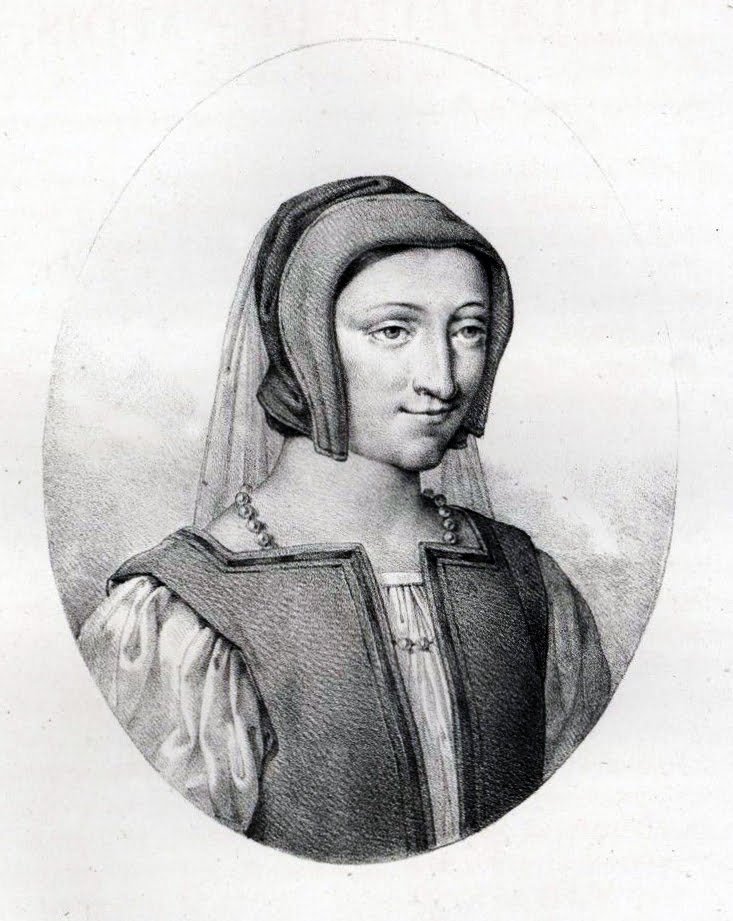
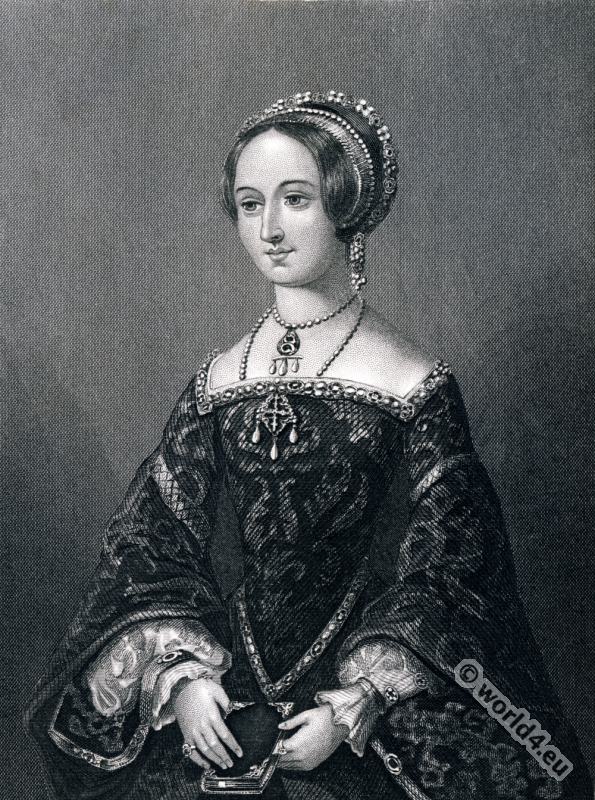
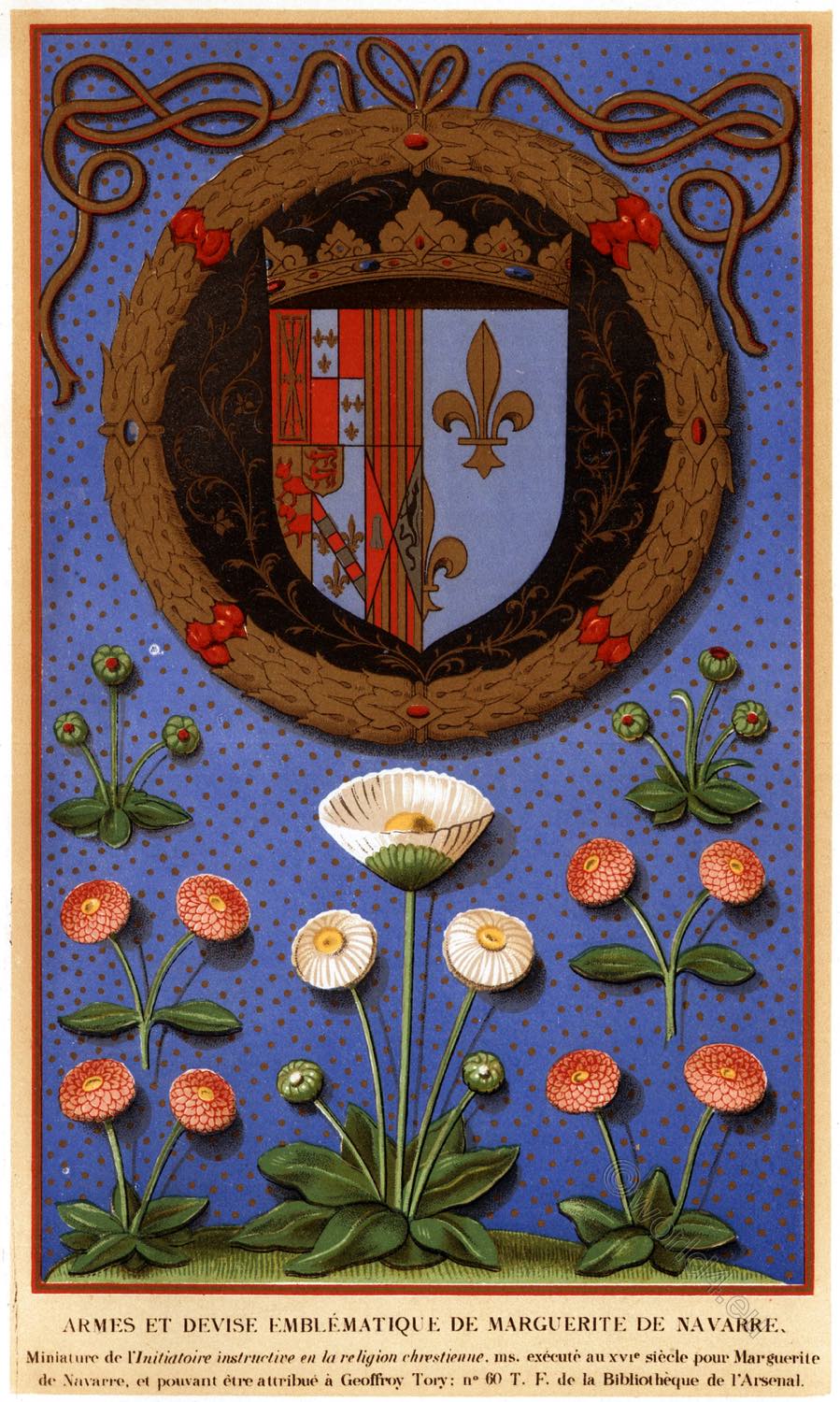
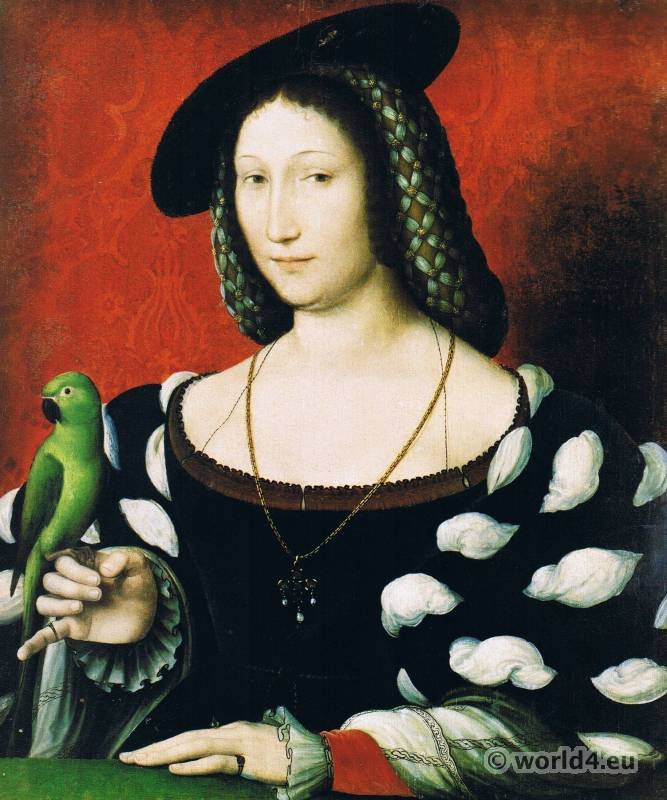
Margaret of Navarre, also Marguerite de Angoulême 1492–1549. She promoted poets, artists and scholars and was even a writer. Her best-known literary work is the Heptaméron. Marguerite is the ancestress of the Bourbon kings of France, being the mother of Jeanne d’Albret, whose son, Henry of Navarre, succeeded as Henry IV of France, the first Bourbon king.
Praetorius, Guédron: Grand Bal à la cour d’Henri IV. – Grand Ball at the court of Henri IV
France 16th to 17th century.
There is no difficulty in ascertaining the relation between the events of a certain period and the fashions of the same date. It may be that if the spirit of the age be serious, if the social community be exposed to severe trials, if continual misfortunes befall the mass of the people, the mode of dress will reflect those vicissitudes of the time; and, generally speaking, such is the case.
Sometimes, on the contrary, extravagance and luxury seem to be flaunted in the very face of the general poverty, and the small prosperous minority are so profoundly indifferent to the misfortunes of the greater part of mankind, that they make not the slightest change in their mode of living, but indulge in every whim and caprice, and continue to bend the knee before the “fickle goddess.”
Universal mourning on the death of the Duc de Guise (Henri I. de Lorraine, duc de Guise 1550- 1588).
A remarkable exception to this rule is worthy of note. It occurred in Paris in December, 1583, immediately after the murder of the Duc de Guise at the États de Blois.
Deep mourning prevailed among the “leaguers” of the capital, and numerous expiatory or funereal processions took place. No fashionable costume was tolerated. “If a demoiselle was seen wearing a ruff ‘à la confusion,’ nay, even a single ‘rabat‘ of extra length, or sleeves too open, or any other superfluous adornment, the people would attack her, drag off her ruff, and even tear her clothes.”


But this, we repeat, was an exception. In the most troubled times of our history, fashion and luxury appear to have yielded none of their rights. Frenchmen, and still more Frenchwomen, feel so imperious a need of pleasure! Ennui comes to them so readily! The love of admiration, or to speak more accurately, the love of elegance and of change is so deeply rooted in the national character. If luxury did not exist in France, we should be compelled to invent it. When it vanishes, we think that all is lost—even our country!
Vertugadins, l’espoitrinement des dames.
It is unnecessary to recall the events of the reign of Henri IV., which began in civil war, and ended with his assassination. The hero of the day, the conqueror at Ivry, the king who “confounded both Mayenne and Iberia,” loved fêtes as much perhaps as battles, for in both he was triumphant over all rivals.
His court followed his example. Men still wore the curls and ringlets of preceding reigns; ladies continued to use masks, so conducive to tricks and adventures of all kinds. Nor did they give up their perfumes, whether ambergris, musk, or cordial water; moreover they astonished the world by the size of their “vertugadins.”
The vertugadin consisted of circles of iron, wood, or whalebone, “resembling the hoops of casks.” These were sewn inside the skirts. It dated from the first half of the sixteenth century, but attained no extraordinary size under the Valois. Many eccentricities may be laid to their charge, as we have seen, but on this point they were tolerably reasonable.
From the first appearance of the vertugadin, which has become a type in the history of Fashion, splints of wood were employed to compress the waist, and give it slenderness and grace. Busks, whalebone bodices, and corsets were used later. The object was to render the waist smaller; hence resulted a whole architectural system intended to compass the result at which our own contemporaries sometimes aim by means of the corset. The waist was so tightly compressed that Henri Estienne speaks of “l’espoitrinement des dames.”
The vertugadin came to us direct from Spain. “In order to obtain a real Spanish figure,” says Montaigne, “what a gehenna of suffering will not women endure, drawn in and compressed by great ‘coches’ entering the very flesh; nay, sometimes they even die thereof?”
During the reign of Henri IV. the gigantic size of the vertugadin, in spite of satire and sarcasm, was not lessened by one inch. In vain was its absurdity manifest. The ladies nearly all looked “like church bells,” to make use of a metaphor for which other historians are responsible. Their bodices were usually buttoned in front, and were cut square at the waist; but they often wore long pointed bodices partially opened in front, and disclosing a white chemisette elegantly trimmed with embroidery or lace. Lace was lavished on every part of the gown—on the wrists, sleeves, and back.
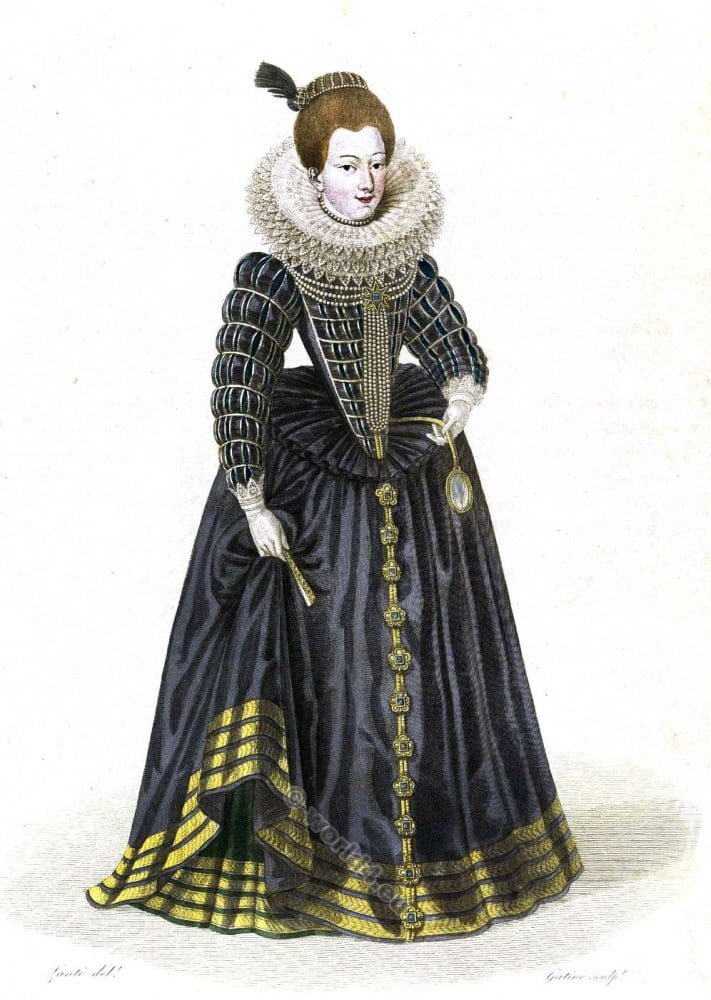
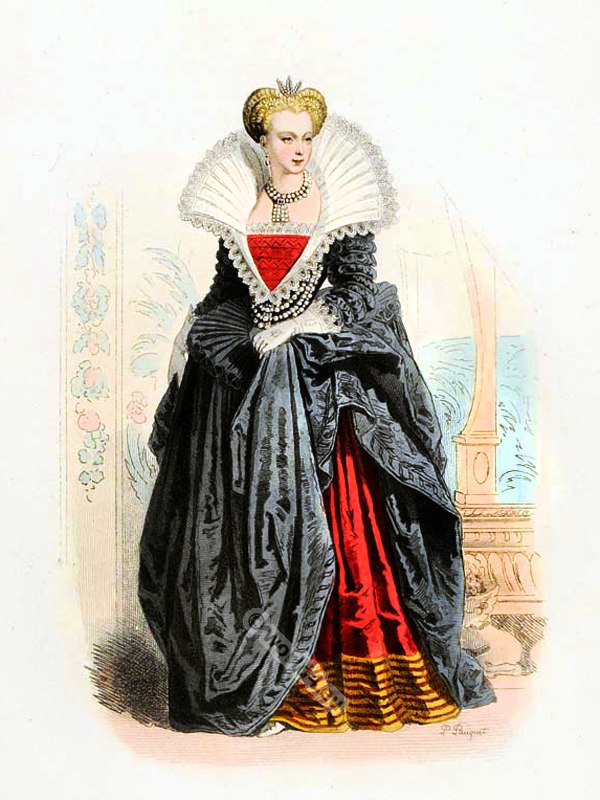


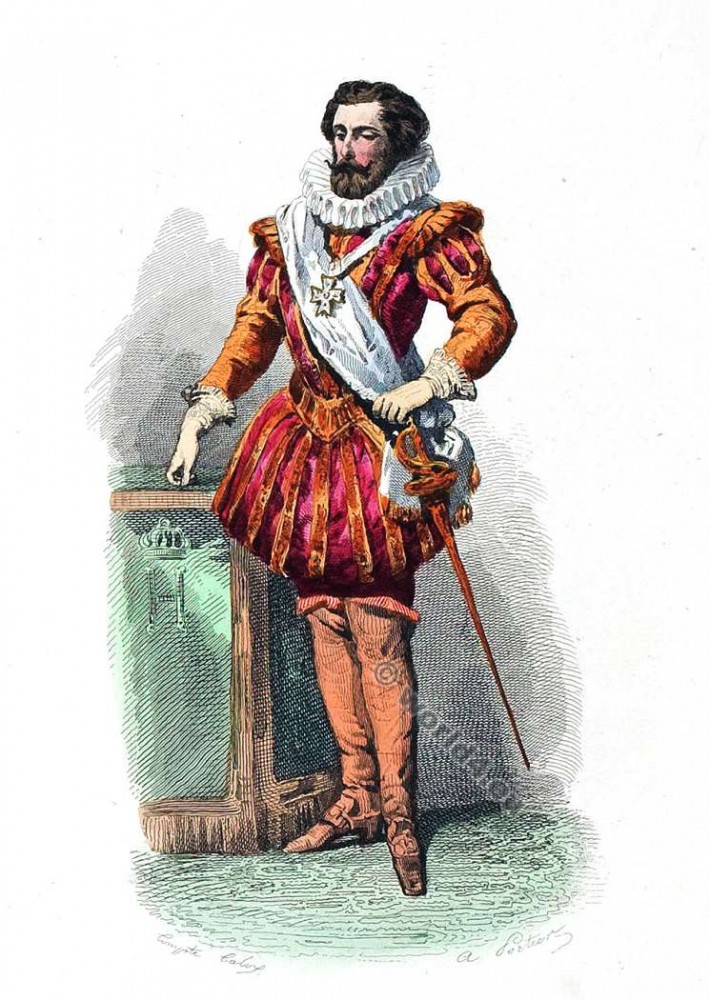
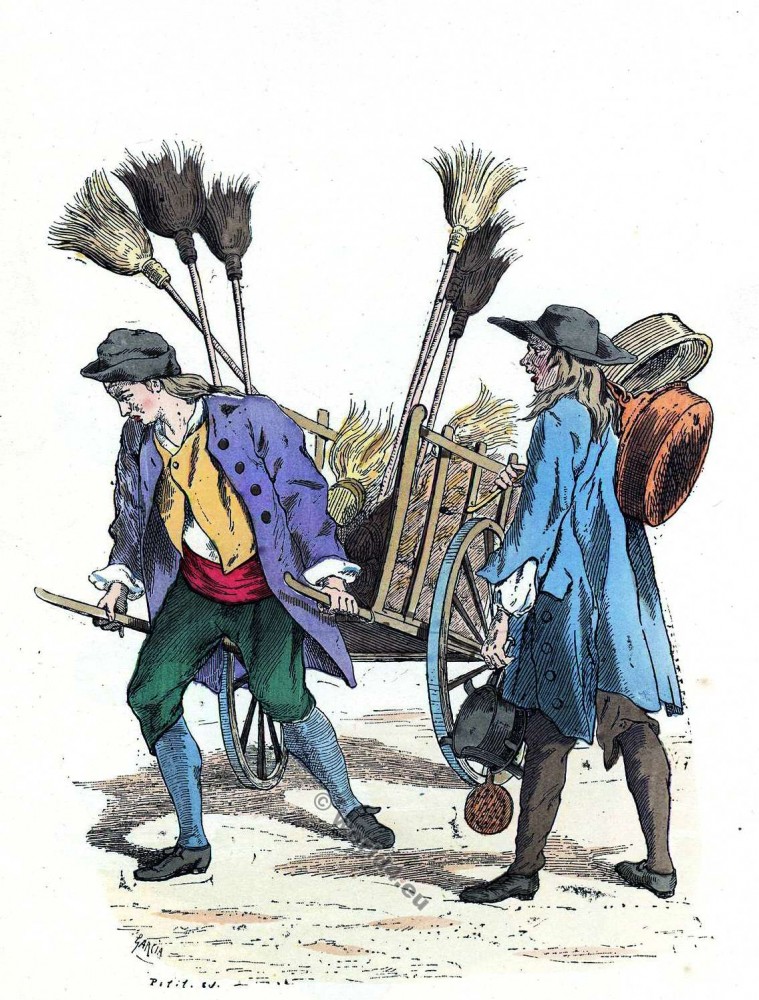
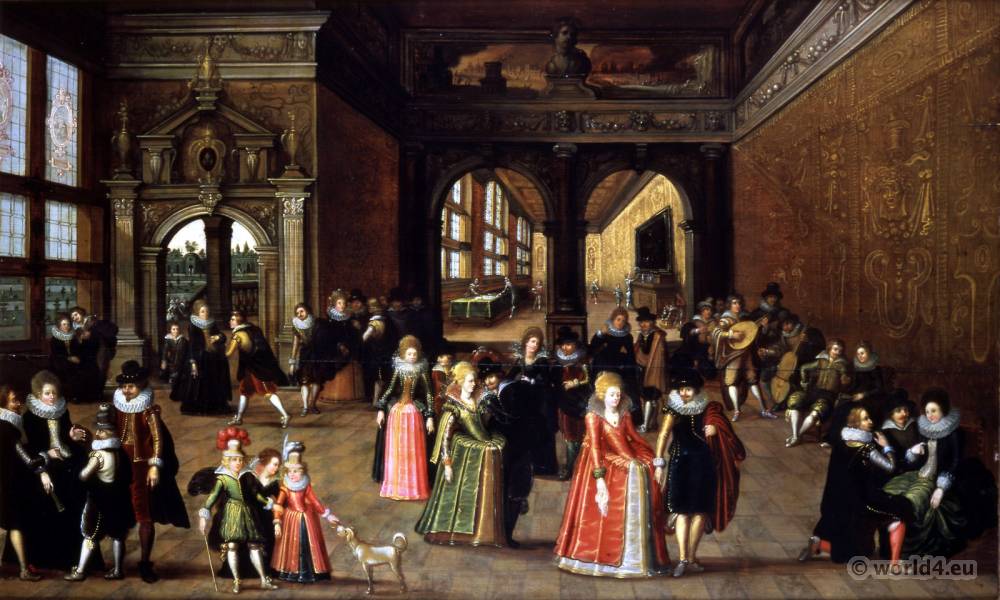
Diversity of colours.
Frenchwomen wore colours, and great was their number—from “rat-colour” to that called “widow’s joy,” or “envenomed monkey,” or “chimney-sweep,” according to D’Aubigné (Théodore Agrippa d’Aubigné 1552-1630).
Gabrielle d’Estrées who wore her hair frizzed and drawn back in the shape of a heart, had a “cotillon” of the colour of “golddust of Turkey.” Her black satin gown, slashed with white, is mentioned by some writers. She paid 1900 crowns for the embroidered handkerchief she carried at a ballet. Some court ladies loaded themselves with such a weight of pearls and jewels that they were unable to move.
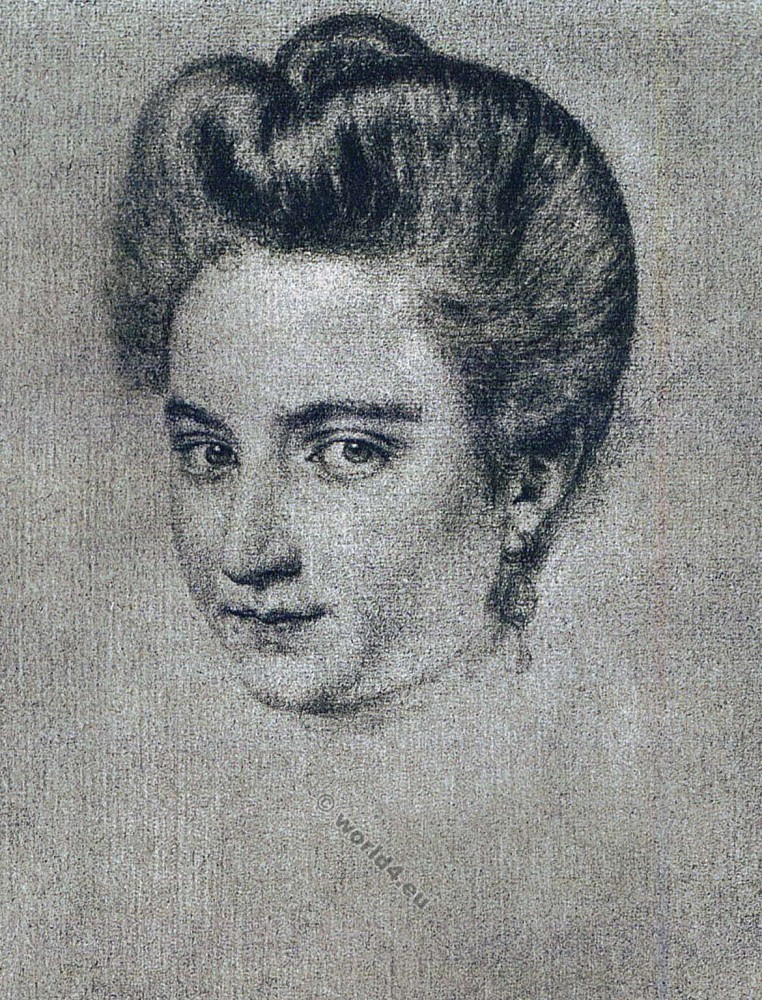

At the baptism of the king’s children, on September 14, 1606, the queen’s gown, covered with “thirty-two thousand pearls and three thousand diamonds, was beyond rivalry, and priceless.” Before that, in 1594, Gabrielle d’Estrées “was so loaded with pearls and sparkling gems that she outshone the light of the torches.” She possessed a “cotte of Turkish cloth of gold, with flowers embroidered in carnation, white, and green,” and a “gown of flowered green velvet, lined with cloth of silver, and trimmed with gold and silver braid, and pipings of carnation satin.” The display of diamonds was destined to increase as time went on.
The reign of the vertugadin, which Mme. de Motteville (Françoise Bertaut de Motteville (c. 1621 – 1689) described as “a round and monstrous machine,” came to an end in 1630. But red silk stockings, called “has de fiammette,” costing more than seventy-five francs a pair, shoes with flaps fastened by a love-knot “à la Choisy” in blue or red satin, and crimson velvet, pattens with high cork soles, survived the vertugadin, as did likewise velvet, miniver, and ermine muffs in winter.
Dress of Marguerite de France
Marguerite de France (Marguerite de Valois; 1553 – 1615, also known as La Reine Margot, was Queen of France and Navarre and Duchess of Valois.), the daughter of Henri II. and wife of Henri IV., is depicted wearing the following costume: Pearl necklace and earrings, open-work fan, kid gloves completely covering the hands and wrists, where they were drawn under white cuffs, a cap, since known as the Marie Stuart cap, her hair frizzed and drawn up symmetrically over the forehead, an under-dress of black satin, the upper one trimmed with gimp, an open fluted collerette, and an immense ruff reaching to the nape of the neck.
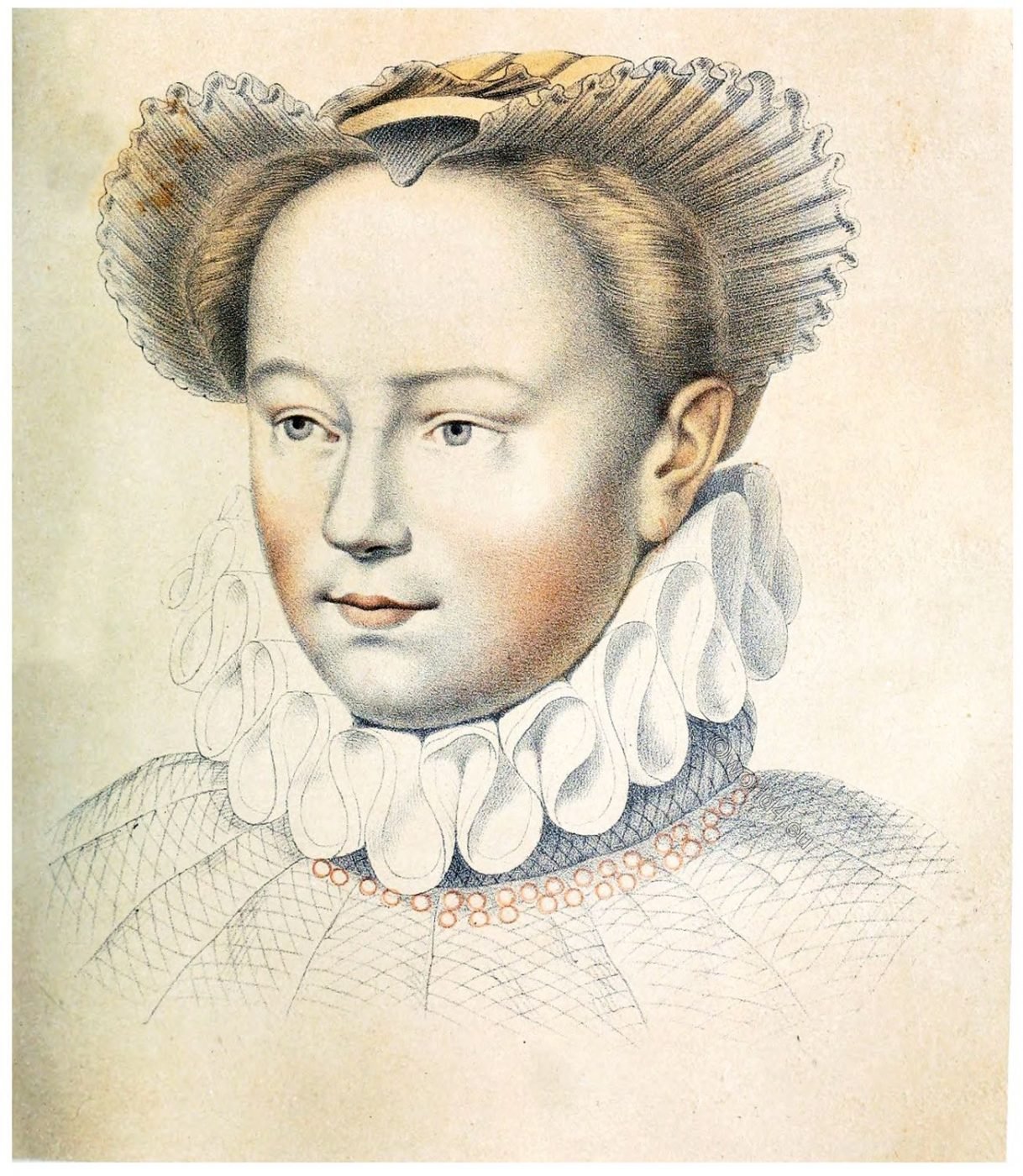
Marguerite de France, whom courtiers called “the goddess,” was extraordinarily beautiful, and was graceful, lively, and fascinating in the highest degree. Her “carrures” (shoulder-breadths) and skirts were made by her orders, it is said, much wider than was necessary. She was enormously stout, and by way of improving her figure applied steel bands to each side ot her waist. There were, it seems, not a few doors through which the fair princess could not pass.
Low-cut bodices.
Gowns were made not only of satin but of velvet, damask, and silk of every colour. There were dresses “à collets débordés,” or with collars falling over the shoulders and upper part of the arm; there were ruffs “à grands godrons,” so cut out and open-worked that the skin was easily discernible behind them; there were belts of exorbitant price, to which were suspended needle-cases, gold-handled scissors, and gold-braided velvet purses.
By degrees, through the fatal effect of bad example, the passion for low-cut bodices assumed a boundless sway. Innocent XI., who was at enmity with France, rebuked this craze from the chair of St. Peter, and showed no greater favour to the weaker sex than to the politicians of France. He issued a bull by which he “enjoined on all women, married and single, to cover their bosoms, shoulders, and arms down to the wrist, with non-transparent materials, on pain of excommunication.”
But the thunderbolts of the Church were hurled in vain, and light, transparent, and low-cut gowns enjoyed a long career. The Vatican and the French Parliament might speak if they chose, but they could not prevail against the customs of the day.
Head-dresses of hair.
Dating from the year 1587, one of the last years of the troubled reign of Henri III., women had taken a violent fancy to wearing hair only as a head-dress, surmounted by a feather. They wore false hair or wigs powdered with violet powder for brunettes, and with iris for fair women. A sort of gum or mucilage kept the hair in its place; their heads seemed to be pasted. The women of the people made use of the dust of rotten oak, and the peasants of flour for the same purpose.
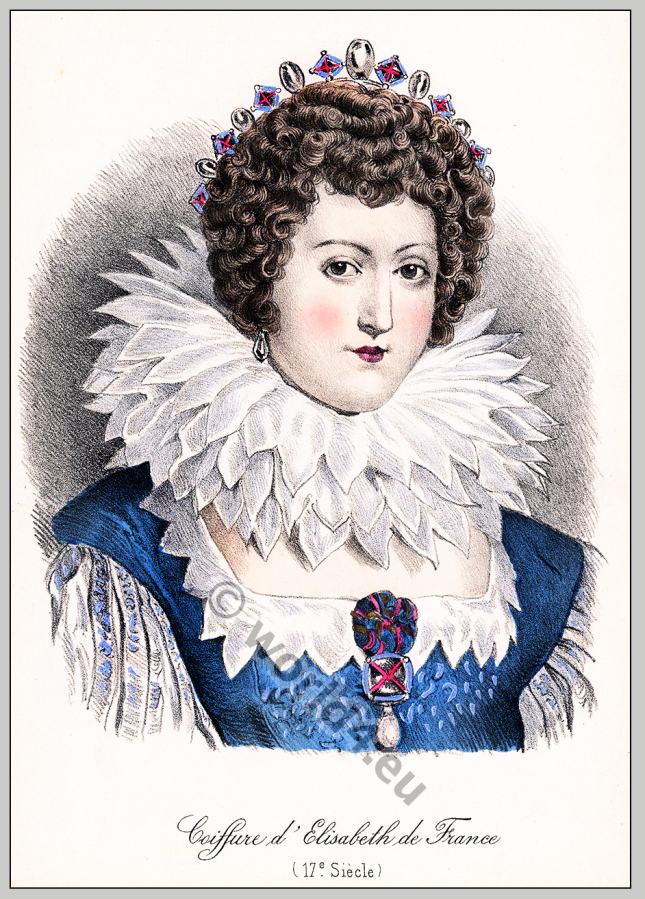

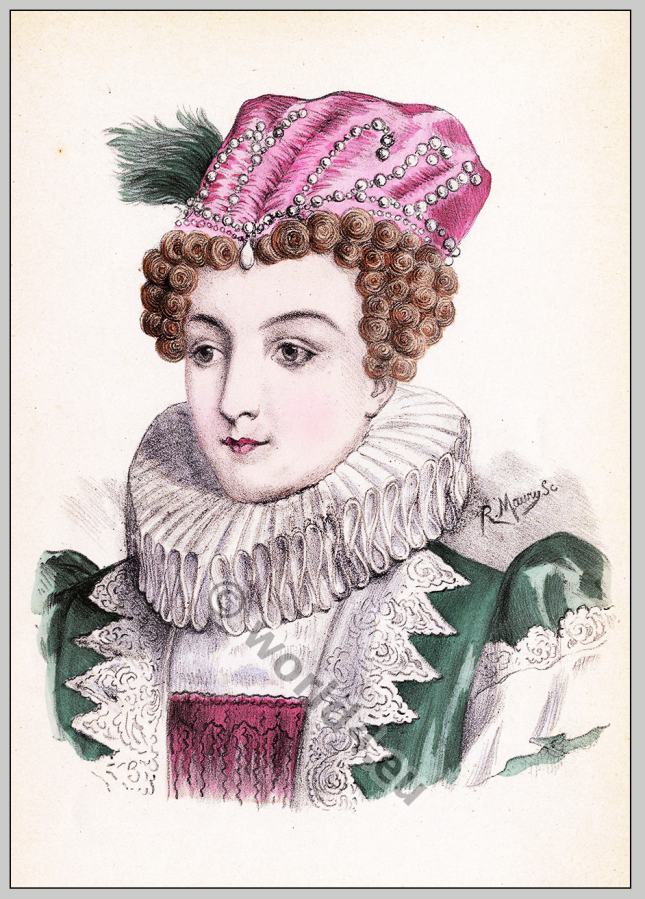
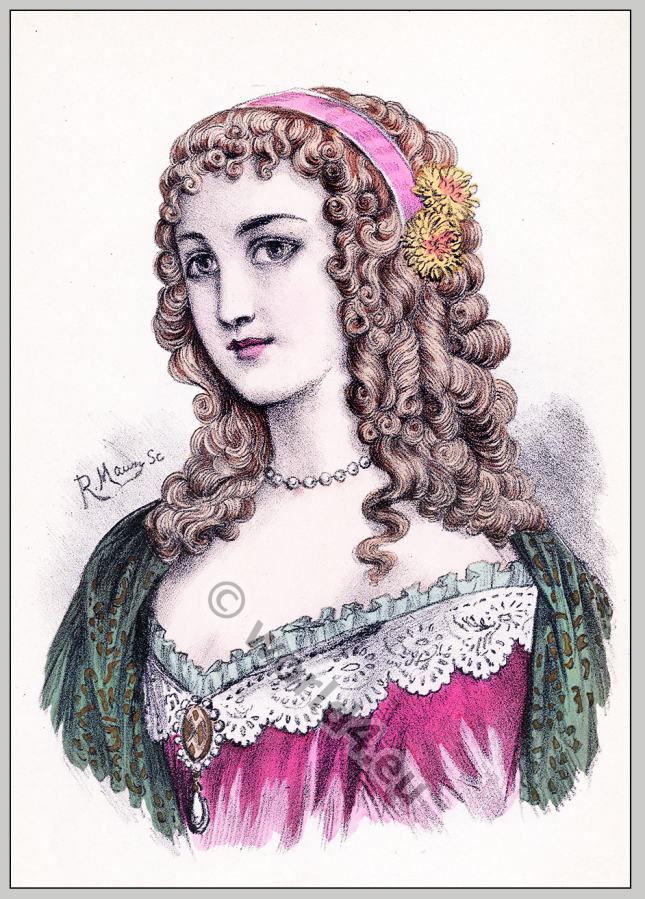
Various styles of head-dresses.
There were four different styles of head-dresses of the period:— First, the “coiffure à boucles frisées,” or curled ringlets, the style of which is sufficiently indicated by its name; secondly, that “à passe fillons;” thirdly, that “à oreillettes,” a hat with a high crown, the material of which being crumpled of itself (naturellement chiffonnée) fell into a quantity of little folds; and, fourthly, the “coiffure à l’espagnole,” or Spanish head-dress.
The latter deserves some notice on account of its elegance and singularity. My readers can imagine the effect of a handsome Spanish toque, embroidered or braided in gold, and artistically placed at the back of the head, with the hair in curls all round the front. In addition, there were several plaits intermingled with ribbons and jewels, which fell lightly on the neck and floated in the wind. This head-dress met with little or no opposition.
Transparent dresses “à l’ange,” or “à la vierge,” skirts of yellow satin, like those of Francion’s wife, and light head-dresses, were worn with very delicate and fanciful shoes. Venetian slippers were much prized, also coloured shoes with high heels.
During the reign of Henri IV., Venetian and Florentine lace became so fashionable in France, that, in justice to native manufacturers, their importation was forbidden. But a system of fraudulent traffic was set up, and French vanity almost got the better of the law. The king chose to banter his minister on the extravagance of women, and Sully immediately took, certain steps which succeeded in temporarily stopping the excess of expenditure on dress.

Edicts of Louis XII.
Louis XIII., the son of Henri III., endeavoured to walk in the path traced out by Sully, and in 1633 and 1634 he issued two fresh edicts lecturing Frenchwomen on their caprices. All the women instantly cried “Shame!” and numberless caricatures were published in defence of their cause.
One artist depicted a steady tradesman of Flanders, reduced to a state of despair, tearing his hair, and wildly cursing things in general, while he tramples his embroideries under foot and exclaims: “Que fait-on publier? que venons-nous d’entendre? Mettons bas la boutique, et de nos passements Faisons des cordes pour nous pendre!” (“What is it that is published? what do we hear? Let us shut up shop, and of our goods make ropes To hang ourselves withal.”)




Caricatures: “Pompe funèbre de la Mode”.
Another print bore the following title: “Pompe funèbre de la Mode, avec les larmcs de Démocrite et les ris d’Héraclite.” Four women are leading Fashion along, followed by a crowd of work-women, barbers, embroiderers, and tailors, who are endeavouring to make the best of their evil fortune, and brandishing, after the fashion of banners, wands laden with lace and finery. In the background is a sarcophagus bearing the following epitaph:- “Ci-gist sous ce tableau, pour I’avoir mérité. La Mode, qui causait tant de folie en France. La mort a fait mourir la superfluity, Et va faire bientôt revivre I’abondance.” (” Here lies under this picture, for having deserved it. Fashion, which caused so much madness in France. Death has put superfluity to death, And will soon revive abundance.”)
Here lieth Fashion! The ladies of the day must have laughed heartily in their sleeve at the notion of the death of Fashion; for how should they admit that it deserved to die? In spite of caricatures it did, in fact, survive, and in face of all the edicts took refuge at court, as its privileged sanctuary, and the natural home of ermine, gold-laced coats, lace, and jewels.
Words and fashions.
Vaugelas, the grammarian, paid tribute to the power of Fashion, when he said: “Words are like fashions. The wise, who know that they must speak and dress like every one else, do not immediately adopt the newest inventions of folly, but only those in general use, and it is equally unreasonable to endeavour to make words or to make fashions, or to refuse to abide by them after they have been publicly recognized.” In other words, custom overrides everything as regards both language and dress, and no one can decree innovations either in speech or in costume, with a chance of being obeyed.
Nor did the Jansenists meet with better success when they attempted to deprive a certain lady of Easter Communion because she had trimmed her pocket-handkerchief with lace. Was it not the fashion?
Ribbons or “galants”.
Meanwhile the mere bourgeoises, who dared not openly defy the sumptuary laws, wore, in place of the lace forbidden them, a quantity of ribbon under the generic name of “gallants.”
Knots of ribbon appeared on the dresses of all the bourgeoises, and even on those of the maid-servants of Moliere’s and Corneille’s time. There were tufts of ribbon on the skirts, bodices, sleeves, and hair. Bourgeoises felt the necessity of wearing ribbons at a time when cavaliers were profusely adorned with them. The whole French people were ribbon mad.
The “chaperon” or hood was still worn by bourgeoises. This was a small coif pointed on the forehead, and with an appendage behind that hung over the shoulders. The point was fastened down by pins. If we may believe the author of “La Chasse au Vieil Grognard,” “nobody was so well dressed, so clean, and so respectable” as the bourgeoises. ” So well mannered, and so agreeable in their speech and conversation, that for the most part they with their daughters would be taken for noble ladies rather than for bourgeoises and shopkeepers.”
Great ladies also condescended to wear hoods, but only in winter. According to Ménage, Anne of Austria introduced the fashion of “garcettes,” which took the place of the padded wigs. The hair was frequently dressed “en tire-bouchons,” or corkscrew-fashion, and in loops, with a “culbute” or ribbon-bow fixed in the chignon.
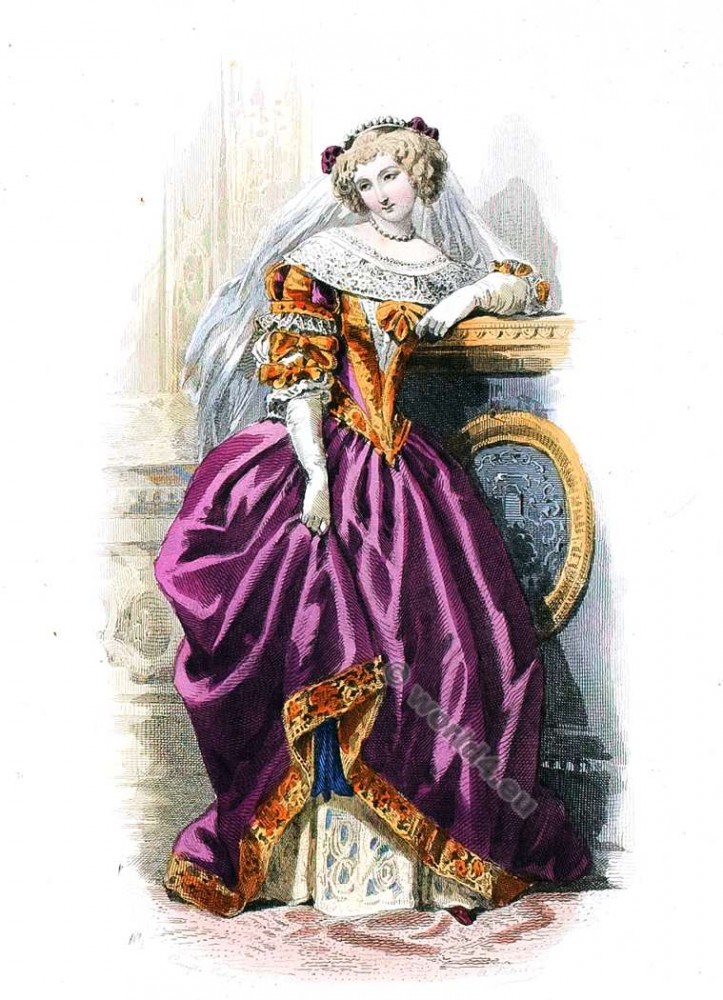
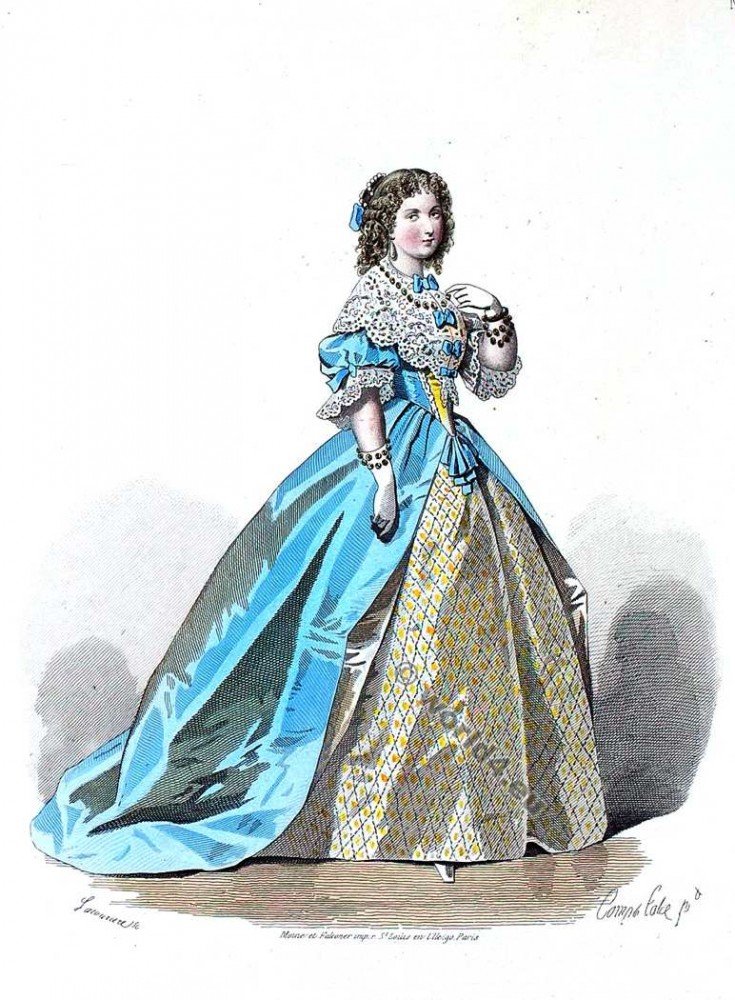
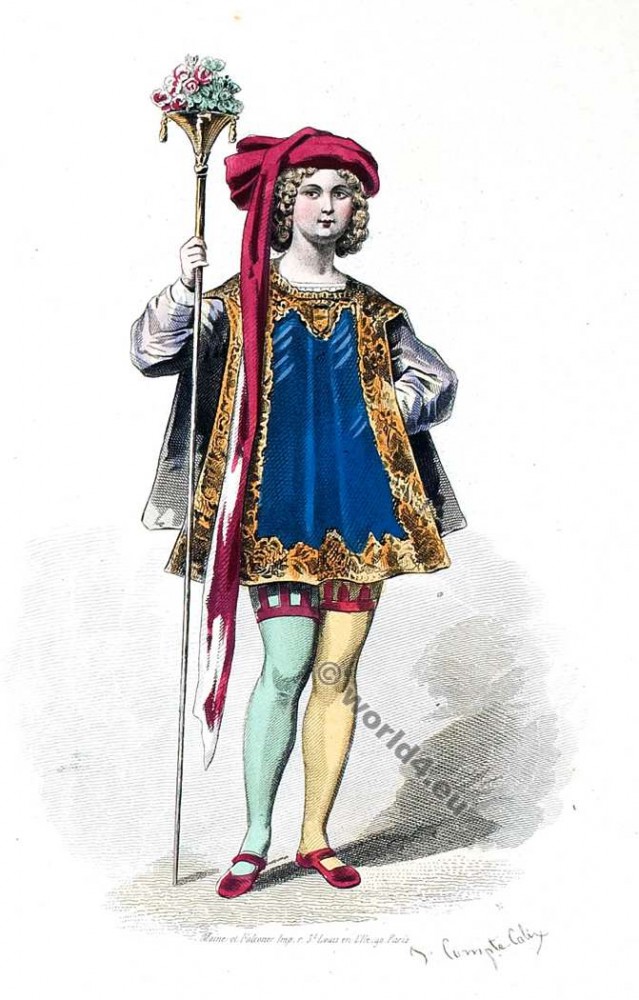


Widows were never seen without a little coif on their heads. After two years’ deep mourning in “guimpe” and mantle, says a modern writer, widows were restricted for the rest of their lives, unless they married again, to black and white made in the simplest manner. Mme. d’Aiguillon, the niece of Cardinal Richelieu (Marie Madeleine de Vignerot du Pontcourlay, Duchesse d’Aiguillon, Pair de France 1604–1675), was the first who ventured to wear colours after her husband’s death. Yet she did not throw aside the hood, which remained in existence under different names—sometimes “languette,” sometimes “bandeau” — until the close of the seventeenth century.
According to St. Simon (Louis de Rouvroy, duc de Saint-Simon 1675-1755), Mme. de Navailles, who died in 1700, was the last widow who wore a “bandeau.”
For undress, great ladies wore small coifs or round caps, fitting close to the head. Servants and women of the people added a kind of flag, which hung down between the shoulders, and was called a “bavolette,” and was probably the forerunner of the “bavolet,” or bonnet-curtain of our own times. Countrywomen wore instead of a coif a thick stitched ” begun,” which is still in use in certain country places. In Picardy it is called a “cale” or “calipète.”
Women of the people wore no gowns, only two petticoats and a bodice; the latter was sometimes laid aside for a “hongreline,” or loose bodice with deep basques, and in all cases an apron. They almost all possessed gold ornaments.
“Demi-ceint” girdles.
The girdle consisted of a “demi-ceint” of silver, and a broad band of silk ornamented with chased or enamelled gold-work. The “demi-ceint” was sometimes worth forty crowns; knives keys, scissors, &c., were suspended to it by a chain. Taken altogether, the dress of a maid-servant was rather complicated.
Feminine attire altered very little under Louis XIII. We may note, however, the muff and the little “muff-dog,” seldom separated from his mistress.
Gloves of all sorts.
Essences were still used, also white lead and vermilion. Every article of dress was scented, including shoes, and especially gloves. There were gloves “à l’occasion,” “à la nécessité,” ” à la cadenet,” “à la Phyllis,” “à la Frangipani” made out of highly perfumed skins, and gloves “à la Néroli,” so called from a princess of that name who had, it seems, invented an exquisite scent.
In the “Discours de la Mode” (1615) we read: “Une dame ne peut jamais estre prisée Si sa perruque n’est mignonnement frisée, Si elle n’a son chef de poudre parfumé Et un millier de noeuds, qui çà qui là semé, Par quatre, cinq ou six rangs, ou bien davantage, Comme sa chevelure, a plus ou moins d’étage.” (“A lady can never be admired If her wig be not trimly curled, If she wears not perfumed powder in her hair, And a multitude of knots, pinned here and there By four, five, or six, or many more, As in her head-dress pleasantly dispersed.”)
Patches.
For the benefit of their complexions, women applied lard to their faces at night.
The “précieuses,” whom Molière thought ridiculous, and who refined our language until they got out of their depth, used to call fans “zephyrs.” This is rather an appropriate expression, and at any rate it is less affected than the euphemism of “baptized mules,” by which they designated the porters of their sedan chairs. Bright coloured silk stockings were still in fashion, and red satin shoes, or little slippers of various hues.
We must call attention to one novelty, the appearance of patches, which are first mentioned in print in 1655, and continued to be in fashion until the time of the Regency, when seven principal patches were recognized.
A patch was simply a small bit of black silk sticking-plaister, placed on the face, which looked all the fairer for the contrast. Each lady placed the patch to suit the expression of her countenance. In the midst of a promenade or street a great lady might be seen suddenly to stop, to open the patch-box she carried everywhere with her, to survey herself in the mirror which lined its lid, and quickly to replace a patch that had fallen off. The fashion of patches was not, as might be imagined, a production of the seventeenth century. It was a reminiscence of early Roman times, during which even orators wore patches when speaking from the Tribune. We may truly say that there is nothing new under the sun.
Masks; their use.
It is said that certain plaisters ordered as a remedy for headache had originally suggested these black spots, and what had been at first prescribed for health’s sake, was retained as an aid and accessory to the beauty of ladies who wished for artificial attractions.
After endeavouring to animate and improve the countenance by patches, the next step was to conceal those faces to which nature had been unkind behind a mask; or else to envelope beauty in mystery, by making its presence doubtful, and exciting the curiosity of the incredulous.
Masks originated in the reign of Henri II. They reappeared in tenfold force under Louis XIII. Ladies avoided recognition by wearing black velvet masks, lined with white satin, that folded in two like a pocket-book. There were no strings with which to fix them on, but a slender silver bar ending in a button was fastened on the inside, and putting this between her teeth, the wearer could hold her mask in its place. Moreover, the tone of the voice was so altered by a mask, that many persons, anxious to avoid satirical remark, kept on their masks in public promenades, at balls, and even in church.
The poet Scarron (Paul Scarron 1610-1660) describes the prettiest kind of mask in his ” Épître Burlesque” to Mme. de Hautefort (Marie de Hautefort 1616-1691):-
“Parlerai-je de fantasques Qui portent dentelle à leurs masques, En chamarrant les trous des yeux, Croyant que le masque est au mieux?
Dirai-je qu’en la canicule, Qua la cave meme Ton brûle, Elles portent panne et velours? Mais ce n’est pas a tous les jours; Qu’au lieu de mouches les coquettes Couvrent leur museau de paillettes, Ont en Louche cannelle et clous, Afin d’avoir le flaire doux, Ou du fenouil que je ne mente, Ou herbe forte comme niente.”
(” Shall I tell of those fanciful creatures, Who wear lace on their masks, And bedecking the eye-holes, Think the mask is perfect? Shall I say that in the dog-days, When one burns even in the cellar, They wear gold cloth and velvet? But it is not every day, That in place of patches our coquettes, Cover their chins with spangles, And chew ginger and cloves, That they may smell sweetly. Or fennel—I lie not— Or a strong herb like mint.”)
“Cache-laid”.
Masks called “loups” were supposed to protect the complexion from sunburn, but this was a mere pretext; the real object was to conceal the face of the wearer. Some ladies thus concealed their plainness, and the loup was also called “cache-laid,” or hide-ugly.
After the death of Louis XIII., when the minority of Louis XIV. afforded an excuse for the troubles of the Fronde, when the great ladies meddled with politics, directed insurrectionary movements, and acquired the name of “belles frondeuses,” masks played a most important part.
The Frondeuses – Mme. de Longueville.
Conspiracies that had been hatched in boudoirs broke out in the streets, and women took up arms and placed themselves at the head of seditious parties. Cardinal Mazarin used to say: “There are three women in France capable of governing or of upsetting three kingdoms: the Duchesse de Longueville, the Princesse Palatine, and the Duchesse de Chevreuse.” These ladies used to go, masked, to the councils of Beaufort or of Condé, so as to escape the observation of the enemies of their cause.
There are portraits in existence of that arch-Frondeuse the Duchesse de Longueville. She is represented with helmet and cuirass; her air and attitude are those of a heroine. Several princesses took, her for their model; and the period is one of note as regards fashion, especially for great diversity in dress. No commands were laid on great lords and ladies in those times of anarchy among the nobles. There was ample liberty, not to say licence, in dress.
“The women,” says a contemporary writer, “shone in jewels at a ball given by Anne of Austria, and as much as they could in beauty also; and others in embroidery, feathers, ribbons, and good looks, each according to her means and the gifts of nature.” But for them liberty in dress was not destined to be of long duration.
Source:
- The history of fashion in France, or, The dress of women from the Gallo-Roman period to the present time by Augustin Challamel, Frances Cashel Hoey, John Lillie. Publisher: New York, Scribner and Welford, 1882.
- Quelques dames du XVIe siecle et leur peintres by Henri Bouchot (1849-1906). Paris: Societe de propagation des livres d’art, 1888.
Related
Discover more from World4 Costume Culture History
Subscribe to get the latest posts sent to your email.



